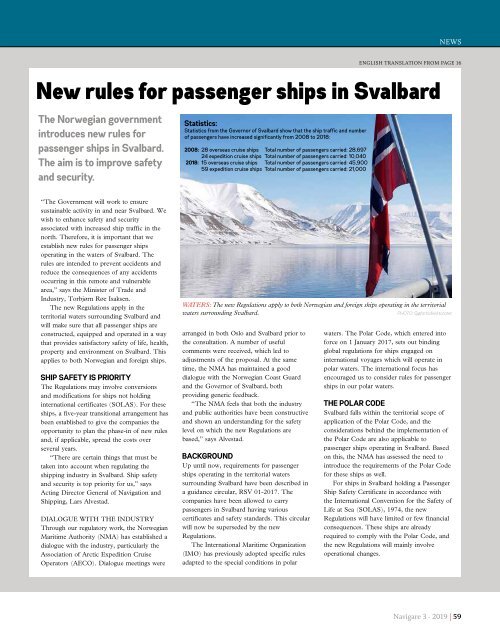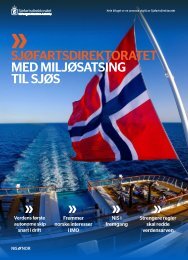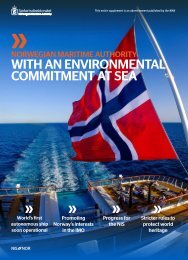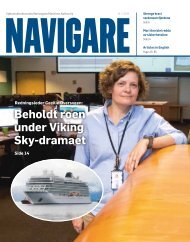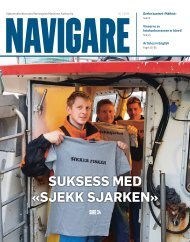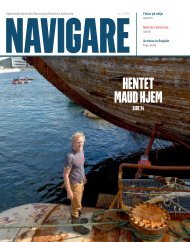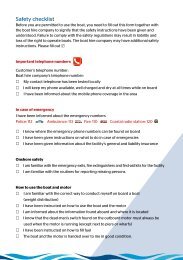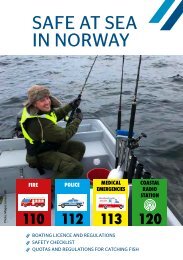Navigare 3 - 2019
Create successful ePaper yourself
Turn your PDF publications into a flip-book with our unique Google optimized e-Paper software.
news<br />
english translation from page 16<br />
New rules for passenger ships in Svalbard<br />
The Norwegian government<br />
introduces new rules for<br />
passenger ships in Svalbard.<br />
The aim is to improve safety<br />
and security.<br />
Statistics:<br />
Statistics from the Governor of Svalbard show that the ship traffic and number<br />
of passengers have increased significantly from 2008 to 2018:<br />
2008: 28 overseas cruise ships Total number of passengers carried: 28,697<br />
24 expedition cruise ships Total number of passengers carried: 10,040<br />
2018: 15 overseas cruise ships Total number of passengers carried: 45,900<br />
59 expedition cruise ships Total number of passengers carried: 21,000<br />
“The Government will work to ensure<br />
sustainable activity in and near Svalbard. We<br />
wish to enhance safety and security<br />
associated with increased ship traffic in the<br />
north. Therefore, it is important that we<br />
establish new rules for passenger ships<br />
operating in the waters of Svalbard. The<br />
rules are intended to prevent accidents and<br />
reduce the consequences of any accidents<br />
occurring in this remote and vulnerable<br />
area,” says the Minister of Trade and<br />
Industry, Torbjørn Røe Isaksen.<br />
The new Regulations apply in the<br />
territorial waters surrounding Svalbard and<br />
will make sure that all passenger ships are<br />
constructed, equipped and operated in a way<br />
that provides satisfactory safety of life, health,<br />
property and environment on Svalbard. This<br />
applies to both Norwegian and foreign ships.<br />
SHIP SAFETY IS PRIORITY<br />
The Regulations may involve conversions<br />
and modifications for ships not holding<br />
international certificates (SOLAS). For these<br />
ships, a five-year transitional arrangement has<br />
been established to give the companies the<br />
opportunity to plan the phase-in of new rules<br />
and, if applicable, spread the costs over<br />
several years.<br />
“There are certain things that must be<br />
taken into account when regulating the<br />
shipping industry in Svalbard. Ship safety<br />
and security is top priority for us,” says<br />
Acting Director General of Navigation and<br />
Shipping, Lars Alvestad.<br />
DIALOGUE WITH THE INDUSTRY<br />
Through our regulatory work, the Norwegian<br />
Maritime Authority (NMA) has established a<br />
dialogue with the industry, particularly the<br />
Association of Arctic Expedition Cruise<br />
Operators (AECO). Dialogue meetings were<br />
WATERS: The new Regulations apply to both Norwegian and foreign ships operating in the territorial<br />
waters surrounding Svalbard.<br />
PHOTO: Sjøfartsdirektoratet<br />
arranged in both Oslo and Svalbard prior to<br />
the consultation. A number of useful<br />
comments were received, which led to<br />
adjustments of the proposal. At the same<br />
time, the NMA has maintained a good<br />
dialogue with the Norwegian Coast Guard<br />
and the Governor of Svalbard, both<br />
providing generic feedback.<br />
“The NMA feels that both the industry<br />
and public authorities have been constructive<br />
and shown an understanding for the safety<br />
level on which the new Regulations are<br />
based,” says Alvestad.<br />
BACKGROUND<br />
Up until now, requirements for passenger<br />
ships operating in the territorial waters<br />
surrounding Svalbard have been described in<br />
a guidance circular, RSV 01-2017. The<br />
companies have been allowed to carry<br />
passengers in Svalbard having various<br />
certificates and safety standards. This circular<br />
will now be superseded by the new<br />
Regulations.<br />
The International Maritime Organization<br />
(IMO) has previously adopted specific rules<br />
adapted to the special conditions in polar<br />
waters. The Polar Code, which entered into<br />
force on 1 January 2017, sets out binding<br />
global regulations for ships engaged on<br />
international voyages which will operate in<br />
polar waters. The international focus has<br />
encouraged us to consider rules for passenger<br />
ships in our polar waters.<br />
THE POLAR CODE<br />
Svalbard falls within the territorial scope of<br />
application of the Polar Code, and the<br />
considerations behind the implementation of<br />
the Polar Code are also applicable to<br />
passenger ships operating in Svalbard. Based<br />
on this, the NMA has assessed the need to<br />
introduce the requirements of the Polar Code<br />
for these ships as well.<br />
For ships in Svalbard holding a Passenger<br />
Ship Safety Certificate in accordance with<br />
the International Convention for the Safety of<br />
Life at Sea (SOLAS), 1974, the new<br />
Regulations will have limited or few financial<br />
consequences. These ships are already<br />
required to comply with the Polar Code, and<br />
the new Regulations will mainly involve<br />
operational changes.<br />
<strong>Navigare</strong> 3 - <strong>2019</strong> | 59


